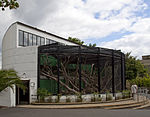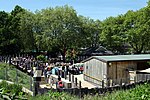Penguin Pool, London Zoo

The Penguin Pool at London Zoo, Regent's Park is a penguin enclosure designed in the International Modernist style by Berthold Lubetkin and the Tecton Group. Constructed in 1934, Historic England describe it as "a key symbol of British (and International) Modern Movement architecture". The pool housed the zoo's collection of penguins for 70 years. Changing attitudes to keeping animals in captivity, and concerns regarding the suitability of the structure for penguin well-being, saw the pool's closure in 2004 and its subsequent replacement by Penguin Beach. After a period of non-use, during which Lubetkin's daughter called for the structure to be "blown to smithereens", the pool was converted into a water feature. It is a Grade I listed building.
Excerpt from the Wikipedia article Penguin Pool, London Zoo (License: CC BY-SA 3.0, Authors, Images).Penguin Pool, London Zoo
Barclay Court, City of Westminster Marylebone
Geographical coordinates (GPS) Address Nearby Places Show on map
Geographical coordinates (GPS)
| Latitude | Longitude |
|---|---|
| N 51.534 ° | E -0.1535 ° |
Address
Lubetkin Pool
Barclay Court
NW1 4RY City of Westminster, Marylebone
England, United Kingdom
Open on Google Maps








